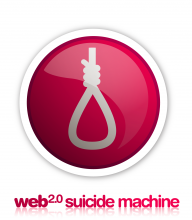Get Your Life Back, Kill Yourself! The Web 2.0 Suicide Machine
In the last few years there have been rising levels of discomfort with online social media for different reasons: the extreme control by the companies that create them, the dubious ways they handle our personal data and their refusal to accommodate anonymity, and the ways in which they have changed the nature of networking both socially and professionally. People want to leave but feel trapped.
Sean Dockeray sums up this conundrum in the Facebook Suicide Bomb Manifesto (written to the Institute for Distributed Creativity mailing list): “We understand perfectly well that our privacy is being renegotiated without our consent; the rules are changing in plain view; but we still participate! It is like a new form of money, something we realize is a myth, but we act like it is real and that is its power. We can’t leave because everyone else is there! Or because we are invested in the myth ourselves.”
In 2009, a collective of net-artists came up with a novel idea; a service to delete virtual identities. The group, Worm Collective, called it the Web 2.0 Suicide Machine. It started as something of a joke but it quickly became a media sensation and in the first month, nearly 1000 people used the service to commit virtual suicide. It works like this: after you give the service your login details, it will systematically go through your account, deleting your friends, your posts, removing you from groups and so on. It will also change your profile photo to memorialise your “death”. It is currently available for Facebook, Twitter, Myspace and Linkedin.
The Suicide Machine follows the lead of Seppukoo, a similar project creating ceremonial “suicides” from Facebook. Seppukoo only deactivated Facebook accounts though, it didn't scrape and clean up personal data as the suicide machine does. But for this, in effect a culture-jamming prank (see the creators other spoofs of Google and Flickr), Facebook filed a legal case against Seppukoo and the service has since shut down (although the website remains to explain the battle with Facebook).
Facebook had the same reaction to the suicide machine, blocking its IP address from accessing Facebook. Worm responded by rerouting their web traffic through proxy services, to access Facebook with different IP's. They only thing they did bend on was to remove the Facebook logo from their website. Gordan Savicic, Suicide Machine's chief euthanasia officer, explained to Buzzblog's Paul McNamara that the reason Twitter, Myspace and Linkedin companies did not respond was likely because they realised what a bad public relations move it had been for Facebook.
FURTHER READING
What are Digital Shadows and Why do they Matter? Me and My Shadow, Tactical Tech
VIDEO
I Have Timeline (parody video comparing Facebook Timeline to an infectious disease), 2012
Walter Langelaar from Worm explains the Suicide Machine project at the Unlike Us conference, 2012

